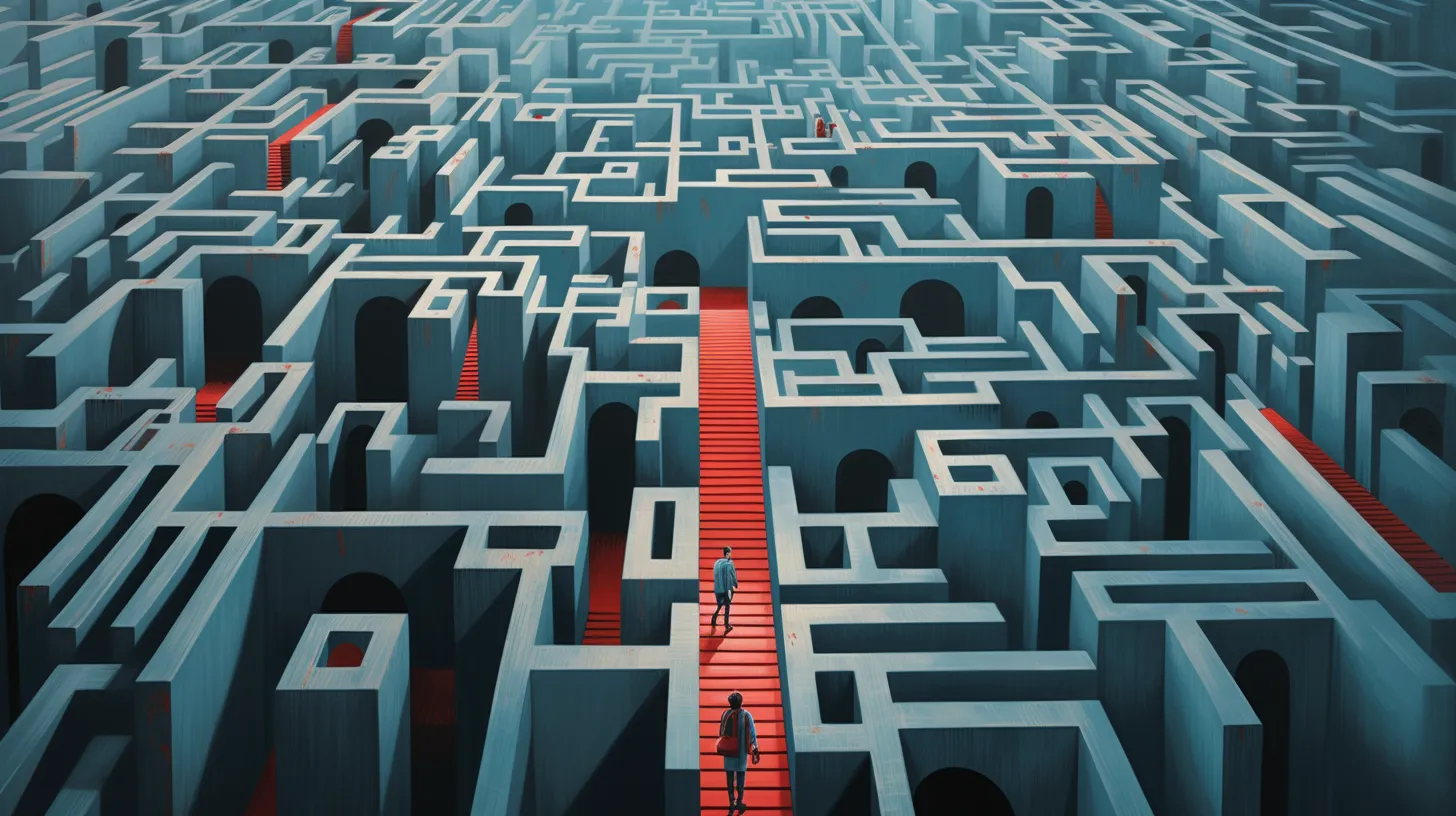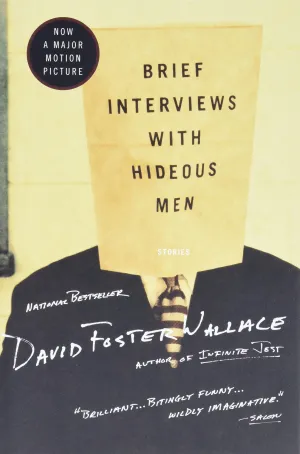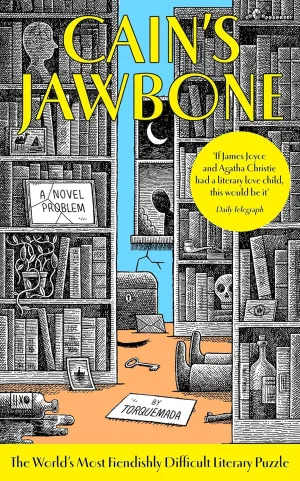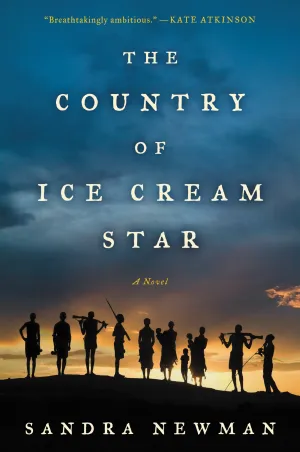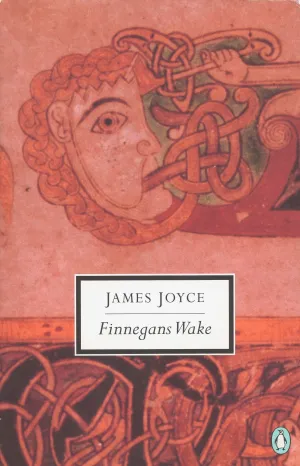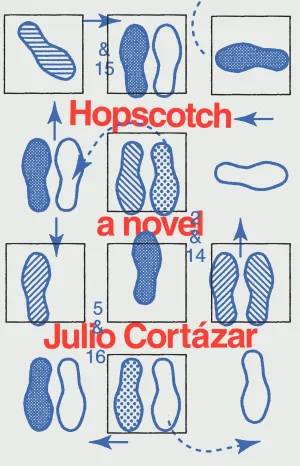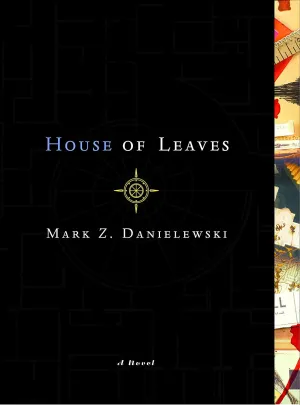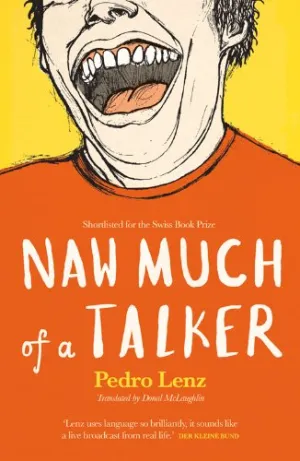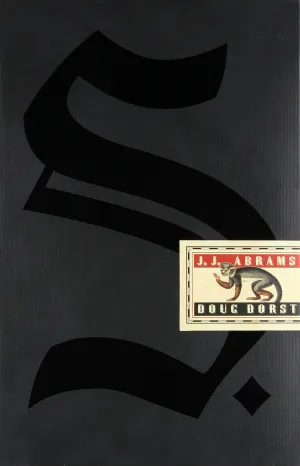Let’s discuss a subgenre of literature where words don’t just sit on the page—but instead celebrate inconvenience and upend the very fabric of storytelling itself.
Exploring the Ergodic Universe
Ergodic is a strange word.
It feels old.
But also sounds like it definitely has something to do with erotica, maybe.Right?
Or, hey, if it’s unrelated to smut, then surely it could be the name of some purposeless, abstruse language, like Esperanto, or French.
Regardless: we can all agree that if it were a noun, it’d fit right in with Lovecraft’s glossary and/or menagerie.
So what the hell is it?
What Ergodic Means
At its core, ergodic fiction is interactive.
But just calling it interactive would be an oversimplification.Or at the very least: a disservice.
More than just being interactive, ergodic texts challenge traditional notions of narrative, linear storytelling—and the very act of reading itself.
Unlike conventional narratives, where readers consume the text linearly/forward, traversing ergodic literature demands careful attention and active participation.
And this participation could be anything.
Quite literally.
Ergodic Etymology
Ergodic comes from Greek words meaning “work” and “path”.
The essence of ergodic literature is that its readers are required to put in extraordinaryBy this I mean “beyond ordinary”; not necessarily “extra difficult”. E.g., every choose-your-own-adventure story you read in elementary school is inherently ergodic. effort to traverse the text. (Aarseth, p.1)
The upside is that this allows the reader to engage with the text in a co-creative process to forge a bespoke understanding.
If regular fiction is like following GPS, then ergodic fiction is like wandering forward with a bad map and a rusty compass.
One path is straightforward.
The other is, if nothing else, more interesting.
And probably more memorable.
Examples of Ergodic Literature
Some ergodic texts use unconventional typesetting, which requires the reader to manipulate the book. Or in some cases: find a nearby mirror
As an example, House of Leaves by Mark Z. Danielewski is both enormously popular and a prime example of modern ergodic literature.
The story has multiple narrators and narrative layers, which are brought to life through footnotes, appendices, varying typefaces, font colors, mirror writing, and, eventually, an disintegration of written language itself.
Here’s one of its funner pages:
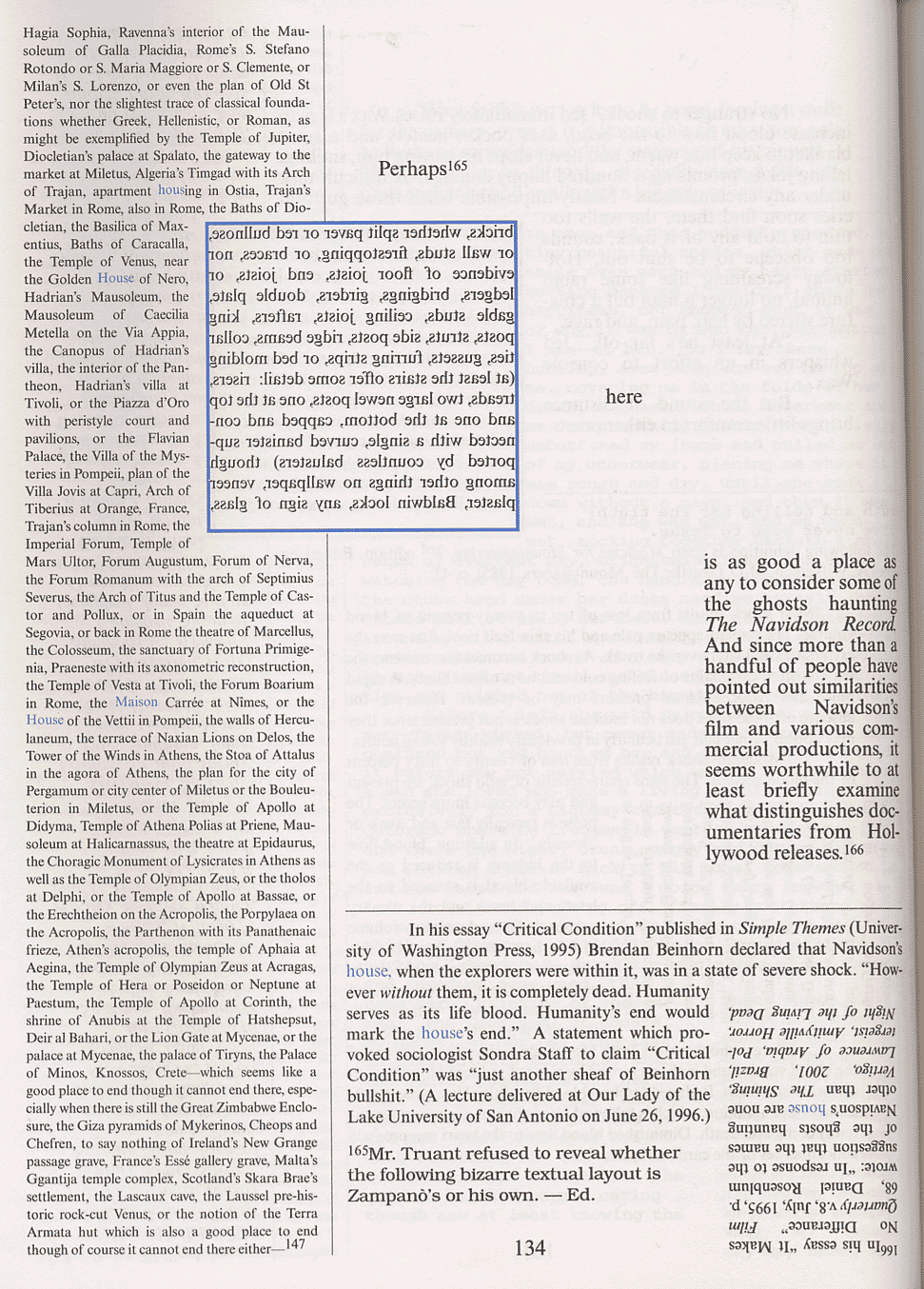
How do you like them picasFor those of you who have never had to spend time in a newsroom: one pica corresponds to one-sixth of an inch. The pica was established by the United States Type Founders’ Association in 1886, and to this day its use remains elemental to the production of print news, website design, and this joke. ?
Others include made-up dialects and/or corruptions of common vernacular, which force the reader to slow way, way down just to make progress:The Country of Ice Cream Star comes readily to mind.
Ya, this been a feary day, because we find a sleeper house. Been two sleepers there, they lain together in a bed. One been grown, one eightish size. Both gone with years to stain and bones. Skeletons mix their ribs, their ghosty hair caught in one tangle.
In houses with these dead, we take no loot. It be unlucky wealth. Nor is good taboo to leave the house. Must rid it with clean fire.
(Newman, p.3)
And some are written in such inaccessible, insufferable brogueNaw Much of a Talker can throw a recovering bartender directly off the wagon. that even the staunchest of pacifists might find themselves alleviating a newfound frustration by harming a housepet, or striking a loved one:
Ah called her a few times an' talked tae her, swore ahd now tae dae wi aw that crap at Cobbles an' that ahd left anythin even remotely tae dae wi drugs behind me, part fae the fact ah know Uli an' Marta, ye cannae dae anythin aboot that but can ye, cos friends ur friends an' they two wur the only two ah hid, ahd known them since nursery, an' wid she, Regula, please fur-fuckin-chrissake believe me please, even the fuckin polis believed me, an' it wisnae as if that didnae tell ye summit if ye stopped tae think aboot it etc.
(Lenz, p.65)
And then there are structural nightmares like Cain’s Jawbone, whose pages aren’t numbered, bound, or sorted at the time of purchase; they’re just heaped in a box. Because of course it’s the reader’s job to arrange them correctly.Julio Cortázar’s Hopscotch dials the spirit of Cain’s Jawbone back a little bit by providing the reader with a Table of Instructions that suggests multiple orders to read the book’s chapters. You can either go with the regular chapter sequence or opt for Cortazar’s recommended sequence. Or make your own. (Un)fortunately, the choice is yours.
And then there are books where whole parts of the text are just fucking missing, and it’s up to the reader to bridge those gaps.E.g. Brief Interviews with Hideous Men, whose narrator’s dialogue—every bit of it—is strictly transcribed as: ‘Q.’
Some books require a visit to a website in order to unearth a key plot point.
Others demand answers to math questions.
Footnotes, and endnotes, and footnotes within footnotes within endnotes, too, can happen.Margin notes, too. And that’s where all the important stuff is typically hiding.
More than a few come with plot-relevant materials jammed between pages; a postcard, a map, a boarding pass.cf. S., which comprises an early twentieth-century literary adventure-slog penned by a Pynchon-esque deity-recluse, an asynchronous interpretive discourse between two modern readers that correspond via handwritten margin notes, and a huge spooky conspiracy that sprawls from the author all the way to present day.
One of my favorites is covered in fur.It sits right beside another book I love, which is written in a language that nobody speaks. Not now. Not ever.
Reading ergodic literature isn’t just about following a storyline from the beginning to the end, is I guess what I’m trying to get across.
It asks readers to invest more than just their time; it asks for their effort, engagement, and sometimes even their analytical skills.
It’s about piecing together fragments, navigating non-linear paths, and sometimes even contributing to the narrative.
Why Ergodic Work Works
But why would anyone want reading to be artificially difficult?I’m pointing at you, Finnegans Wake.
The beauty of ergodic literature lies in its ability to provide a unique reading experience.
The effort readers put into navigating the text rewards them with a sense of accomplishment, discovery, and a deeper engagement with the material.
Every reader might come away with a slightly different interpretation or experience, making each journey through the text unique.
In essence, ergodic literature redefines the relationship between the reader and the text.
It’s not just a story being told to someone; it’s a collaborative experience where the story unfolds with the reader’s involvement.
The Work-Path of Ergodic Literature
So we know that ergodic literature doesn’t follow a straight storyline like traditional novels.
But why bother with all the extra work?
The point of ergodicity isn’t just the content of the story;Nor is it about contempt for the reader. In most cases, anyway. it’s about the form the story takes and the unique journey each reader embarks on to uncover it.
A wise person once said unto the unwashed masses: “Life is what happens to us while we’re making other plans,”(Saunders, p.32).You are not alone. I, too, was under the impression that Lennon coined this one. And that’s all that ergodicity is trying to say.
Readers have to piece together the narrative puzzle, making choices about what to read, in what order, and how to interpret it.
It’s a journey, not a destination.
Ergodic Literature and the Reader-Author Boundary
What sets ergodic literature apart is the way it blurs the boundary between author and reader. J. Espen Aarseth, a leading scholar in the field of ergodic literature, summarizes the difference between a reader of traditional literature and a reader of ergodic literature (for clarity: Aarseth coins and uses the term cybertext to refer to ergodic narratives):
A reader, however strongly engaged in the unfolding of a narrative, is powerless. Like a spectator at a soccer game, he may speculate, conjecture, extrapolate, even shout abuse, but he is not a player. Like a passenger on a train, he can study and interpret the shifting landscape, he may rest his eyes wherever he pleases, even release the emergency brake and step off, but he is not free to move the tracks in a different direction. He cannot have the player's pleasure of influence: "Let's see what happens when I do this." The reader's pleasure is the pleasure of the voyeur. Safe, but impotent.
The cybertext reader, on the other hand, is not safe, and therefore, it can be argued, she is not a reader. The cybertext puts its would-be reader at risk: the risk of rejection. The effort and energy demanded by the cybertext of its reader raise the stakes of interpretation to those of intervention. Trying to know a cybertext is an investment of personal improvisation that can result in either intimacy or failure. The tensions at work in a cybertext, while not incompatible with those of narrative desire, are also something more: a struggle not merely for interpretative insight but also for narrative control: "I want this text to tell my story; the story that could not be without me."
(Aarseth, p.4)
The Future of Ergodic Literature
Even though ergodic literature has been around for a while,An argument could be made that the I Ching (c.900 BCE) is an ergodic artifact. From Wikipedia: I Ching divination is a form of cleromancy applied to the I Ching. The text of the I Ching consists of sixty-four hexagrams: six-line figures of yin (broken) or yang (solid) lines, and commentaries on them. There are two main methods of building up the lines of the hexagram, using either 50 yarrow stalks or three coins. Some of the lines may be designated “old” lines, in which case the lines are subsequently changed to create a second hexagram. The text relating to the hexagram(s) and old lines (if any) is studied, and the meanings derived from such study can be interpreted as an oracle. it’s still a relatively unexplored genre.
This means there’s plenty of room for innovation and novel approaches.Pun intended.
Ergodic literature will continue to evolve with digital media and interactive storytelling.
The Challenges and Rewards of Ergodic Literature
Ergodic literature is not for the faint-hearted. It demands effort, engagement, and sometimes even a bit of detective work.
But for those willing to embark on this journey, the rewards are immense.
It offers a reading experience that is dynamic, immersive, and profoundly personal.
It’s a way of reading that truly reflects our interactive, interconnected world.
It reminds us that reading is not just about consuming information; it’s about creating meaning.
